Loudoun Emergency Warning Sirens: Difference between revisions
ArxCyberwolf (talk | contribs) (Added images.) |
ArxCyberwolf (talk | contribs) mNo edit summary |
||
| Line 1: | Line 1: | ||
{{Infobox siren|title=Loudoun Emergency Warning Sirens | {{Infobox siren|title=Loudoun Emergency Warning Sirens | ||
---- | ---- | ||
Loudoun Master Blaster|company=Loudoun Communications|produced=1989?-present|type=[[ | Loudoun Master Blaster|company=Loudoun Communications|produced=1989?-present|type=[[Directional]] [[Electronic]]|output=115 dB @ 100 ft (Model ES-4000)|sheet=https://loudouncomm.net/wp-content/uploads/2014/12/Siren-Data-Sheet-2015.pdf|wattage=375-500 W (CJ-46 siren) | ||
1200 W (Model ES-2000 onwards)|voltage=12 V DC (controller, Model ES-2000) | 1200 W (Model ES-2000 onwards)|voltage=12 V DC (controller, Model ES-2000) | ||
<div>120 V AC (amplifier, Model ES-2000)</div> | <div>120 V AC (amplifier, Model ES-2000)</div> | ||
| Line 13: | Line 13: | ||
[[File:Loudoun ES1000 controller.jpg|left|thumb|160x160px|A controller used on the CJ-46 siren.]] | [[File:Loudoun ES1000 controller.jpg|left|thumb|160x160px|A controller used on the CJ-46 siren.]] | ||
[[File:Loudoun Whelen Comparison.png|thumb|160x160px|A handy diagram by Aaron P. depicting the differences between the Loudoun CJ-46 siren and the Whelen WS-1000.]] | [[File:Loudoun Whelen Comparison.png|thumb|160x160px|A handy diagram by Aaron P. depicting the differences between the Loudoun CJ-46 siren and the Whelen WS-1000.]] | ||
The sirens are hooked up to a basic early 12 V DC (assuming that these run on the same controllers as the Model ES-2000) Loudoun controller, which is able to perform the standard Steady and Up/Down tones. The siren's amplifier runs on 120 V AC however, making it incapable of running solely on batteries. The controls used on these units seem to be similar to those used on Model ES-2000s, although there are slight differences in terms of the enclosures and the pitch on the CJ-46 sirens peaks considerably higher compared to later models. These do not exist outside of Georgia, suggesting that they were most likely produced post-1978, when Loudoun relocated their operations to Douglasville; One source also suggests that at least 1 unit was produced in 1985, though this is again unconfirmed. These have been described as exceptionally quiet, though this may simply be due to the controllers wearing out; one particular unit in rural Covington, GA was reported to the county EMA by the writer of this article for this suspected issue and was described as considerably louder in a recording following its repair<ref>https://www.youtube.com/watch?v=-jCIF7Su4gY</ref>, although what exactly this repair consisted of and what the problem was to begin with was unclear. These sirens are often confused with [[Whelen WS-1000]]<nowiki/>s for their similar appearance at first glance; they share several key differences, such as their control enclosures and driver covers, or lack thereof. | The sirens are hooked up to a basic early 12 V DC (assuming that these run on the same controllers as the Model ES-2000) Loudoun controller, which is able to perform the standard Steady and Up/Down tones. The siren's amplifier runs on 120 V AC however, making it incapable of running solely on batteries. The controls used on these units seem to be similar to those used on Model ES-2000s, although there are slight differences in terms of the enclosures and the pitch on the CJ-46 sirens peaks considerably higher compared to later models. These do not exist outside of Georgia, suggesting that they were most likely produced post-1978, when Loudoun relocated their operations to Douglasville; One source also suggests that at least 1 unit was produced in 1985, though this is again unconfirmed. These have been described as exceptionally quiet, though this may simply be due to the controllers wearing out; one particular unit in rural Covington, GA was reported to the county EMA by the writer of this article for this suspected issue and was described as considerably louder in a recording following its repair<ref>https://www.youtube.com/watch?v=-jCIF7Su4gY</ref>, although what exactly this repair consisted of and what the problem was to begin with was unclear. These sirens are often confused with [[Whelen WS-1000]]<nowiki/>s for their similar appearance at first glance; they share several key differences, such as their control enclosures and driver covers, or lack thereof. | ||
[[File:Loudoun ES-2000.jpg|left|thumb|160x160px|A Model ES-2000 siren, located in Patriot, IN,]] | [[File:Loudoun ES-2000.jpg|left|thumb|160x160px|A Model ES-2000 siren, located in Patriot, IN,]] | ||
Revision as of 00:54, 23 October 2024
| Loudoun Emergency Warning Sirens
Loudoun Master Blaster | |
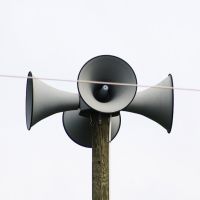
| |
| Company | Loudoun Communications |
|---|---|
| Produced | 1989?-present |
| Type | Directional Electronic |
| Sound output | 115 dB @ 100 ft (Model ES-4000) |
| Wattage | 375-500 W (CJ-46 siren)
1200 W (Model ES-2000 onwards) |
| Voltage | 12 V DC (controller, Model ES-2000)
120 V AC (amplifier, Model ES-2000)
24 V DC (Model ES-4000 onwards) |
| Documentation | Product sheet |
Loudoun's Emergency Warning Sirens series, also known as the Master Blaster (also written MasterBlaster or Masterblaster), are a series of omnidirectional electronic sirens produced by Loudoun Communications, a Douglasville, GA-based dealer of radios and related equipment, and is marketed under Loudoun's "specialty equipment" line. Ever since the series' introduction, it has been a regional success although they've found trouble establishing themselves out-of-state. Despite this setback, the sirens have proven themselves to be a reliable choice and are a common sight in communities in north-central Georgia, primarily competing with Federal and Whelen.
Products
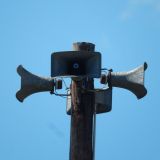
CJ-46 siren (Model "ES-1000")
Before Loudoun finalized their designs, they sold a siren which utilized black rectangular paging horns and lacks a known model name. These are often referred to as "black array Loudouns" or "ES-1000"s (the latter being derived from pure speculation and having no evidence supporting its existence, though supposed documents detailing a FEMA grant to Newton County, GA make mention of the aforementioned name as well as an "ES-3000"). Although little to nothing is known about these, they were most likely a product of Loudoun, as they utilize controllers which would later be seen on the Model ES-2000. Loudoun themselves however claim that they either never produced these sirens or do not remember making them. All of these sirens share the same basic and relatively unprofessional setup, consisting of 4 125 W speaker drivers of varying manufacturer (which are unprotected from the elements) attached to Atlas CJ-46 paging horns mounted to a pole, sometimes at a slightly skewed angle. 3 speaker units were also available. A handful of these, which are either later units of these sirens or early Model ES-2000 units, utilize DR-72 horns, which would later be carried over to the ES-2000. Proper brackets for (most) of these sirens were not supplied, leading to some units have very irregular mounting configurations, as is the case for many of the water tower mounted units in Newton County.
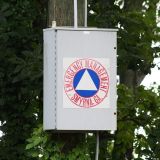
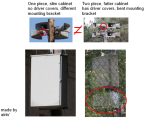
The sirens are hooked up to a basic early 12 V DC (assuming that these run on the same controllers as the Model ES-2000) Loudoun controller, which is able to perform the standard Steady and Up/Down tones. The siren's amplifier runs on 120 V AC however, making it incapable of running solely on batteries. The controls used on these units seem to be similar to those used on Model ES-2000s, although there are slight differences in terms of the enclosures and the pitch on the CJ-46 sirens peaks considerably higher compared to later models. These do not exist outside of Georgia, suggesting that they were most likely produced post-1978, when Loudoun relocated their operations to Douglasville; One source also suggests that at least 1 unit was produced in 1985, though this is again unconfirmed. These have been described as exceptionally quiet, though this may simply be due to the controllers wearing out; one particular unit in rural Covington, GA was reported to the county EMA by the writer of this article for this suspected issue and was described as considerably louder in a recording following its repair[1], although what exactly this repair consisted of and what the problem was to begin with was unclear. These sirens are often confused with Whelen WS-1000s for their similar appearance at first glance; they share several key differences, such as their control enclosures and driver covers, or lack thereof.
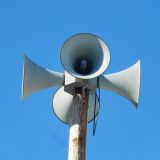
Model ES-2000
The Model ES-2000, introduced sometime either in the late 1990s or early 2000s, would pave the way for the designs of Loudoun's sirens going forward and would right many of the CJ-46 siren's wrongs. The Model ES-2000 utilizes 8 150 W drivers (with 2 drivers sharing a throat for each horn), pushing the total wattage up to 1200 W. The drivers are enclosed in an octagonal housing made of fiberglass which improves their longevity. The octagonal housing also has a service door built into one of its sides, providing relatively easy maintenance to the drivers. This housing's exact proportions and coloration are irregular and can vary by unit. The CJ-46 horns used on the previous siren would be swapped out with larger circular DR-72 horns for the Model ES-2000, likely boosting its output and range. Older units' horns' have an Atlas Soundolier sticker on the tip of the throats, while newer ones simply have an AtlasIED "A" sticker. The entire assembly is mounted to a pole via 4 L-brackets connected to the base of the driver housing.
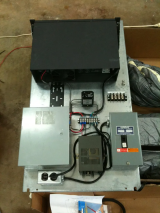
The Model ES-2000 utilizes the same controller seen on the CJ-46 sirens, with little to no differences observed between the two, aside from peaking at a lower pitch. Like its predecessor, while the controller runs on 12 V DC, the amplifier runs on 120 V AC, also making it incapable of running solely on batteries. The Model ES-2000, compared to its predecessor, sold relatively well, with Henry County, Georgia and the aforementioned Newton County being a few examples of communities utilizing them. It is unknown when the Model ES-2000 ended production; it is not mentioned on the small amount of WayBack Machine archives of Loudoun's website before the late 2010s, and the potential of the Model "ES-3000" existing only adds to the confusion. At the very latest, discrediting the Model "ES-3000"'s existence, it was sold up no later than 2008, which marked the first mention of the Model ES-4000 on Loudoun's website.
Model "ES-3000"
The Model "ES-3000" is a siren which was purportedly sold by Loudoun for an unknown period of time. According to an alleged document detailing a FEMA grant, at least a handful of these were installed, alongside "ES-1000"s, particularly one in Covington, Georgia. The source for this comes from a Facebook comment under a discussion about a theorized "ES-1000" in Newton County. </ref> The poster has been contacted and is in the process of trying to find the document; until it's found, the Model "ES-3000" remains unconfirmed. Absolutely nothing is known about these, and there is very little evidence to support their existence apart from the supposed FEMA document, aside from the jump from "2000" to "4000" being slightly unusual otherwise. It is unknown what this siren looks like, but it would most likely share the same head as the Model ES-2000.
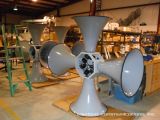
Model ES-4000
The Model ES-4000 superseded the Model ES-2000 sometime before or during 2008 and would go on to become Loudoun's most popular siren, even with its eventual discontinuation.
WIP
Model ES-5000DC
WIP